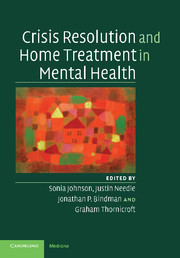Book contents
- Frontmatter
- Contents
- List of contributors
- Foreword
- Acknowledgements
- Section 1 Introduction and concepts
- Section 2 The evidence
- Section 3 Current practice
- 6 Crisis resolution teams: rationale and core model
- 7 The crisis resolution team within the community service system
- 8 Assessment of crises
- 9 Assessment and management of risk
- 10 Symptom management
- 11 Practical psychosocial interventions
- 12 Working with families and social networks
- 13 Strategies for promoting engagement and treatment adherence
- 14 Mixed blessings: service user experience of crisis teams
- 15 Early discharge and joint working between crisis teams and hospital services
- 16 Working with repeat users of crisis resolution services
- 17 Responding to diversity in home treatment
- 18 Coercion and compulsion in crisis resolution teams
- Section 4 Variations and enhancements
- Section 5 Developing a local service
- Index
- References
8 - Assessment of crises
from Section 3 - Current practice
Published online by Cambridge University Press: 13 August 2009
- Frontmatter
- Contents
- List of contributors
- Foreword
- Acknowledgements
- Section 1 Introduction and concepts
- Section 2 The evidence
- Section 3 Current practice
- 6 Crisis resolution teams: rationale and core model
- 7 The crisis resolution team within the community service system
- 8 Assessment of crises
- 9 Assessment and management of risk
- 10 Symptom management
- 11 Practical psychosocial interventions
- 12 Working with families and social networks
- 13 Strategies for promoting engagement and treatment adherence
- 14 Mixed blessings: service user experience of crisis teams
- 15 Early discharge and joint working between crisis teams and hospital services
- 16 Working with repeat users of crisis resolution services
- 17 Responding to diversity in home treatment
- 18 Coercion and compulsion in crisis resolution teams
- Section 4 Variations and enhancements
- Section 5 Developing a local service
- Index
- References
Summary
A comprehensive assessment of the nature of a crisis needs to include not only the individual's mental state but also their domestic circumstances and social network. A key outcome of this assessment is determining who is suitable for home treatment. This chapter is in two parts. In the first, John Hoult provides clinical guidance on the process of taking and accepting referrals, information gathering and the issues most important for initial decision making. In the second, Mary-Anne Cotton then reviews the literature on the factors relevant to determining suitability for home treatment.
Taking and accepting referrals
Who is suitable for referral to a crisis resolution team?
In England, the Mental Health Policy Implementation Guide for the 335 CRTs set up by the Department of Health (2001) states (p. 11) that the services should be for those ‘with severe mental illness (e.g. schizophrenia, bipolar affective disorder and severe depressive disorders) with an acute psychiatric crisis of such severity that without the involvement of a CRT hospitalization would be necessary’. While we agree that this group of patients is the main focus of crisis resolution teams (CRTs), the list of individuals for whom the guidelines say the service is not appropriate is too extensive. People with an exclusive diagnosis of personality disorder do get into acute crisis and often do get admitted to hospital; however, CRTs can usually prevent this with brief intervention.
- Type
- Chapter
- Information
- Crisis Resolution and Home Treatment in Mental Health , pp. 97 - 110Publisher: Cambridge University PressPrint publication year: 2008



